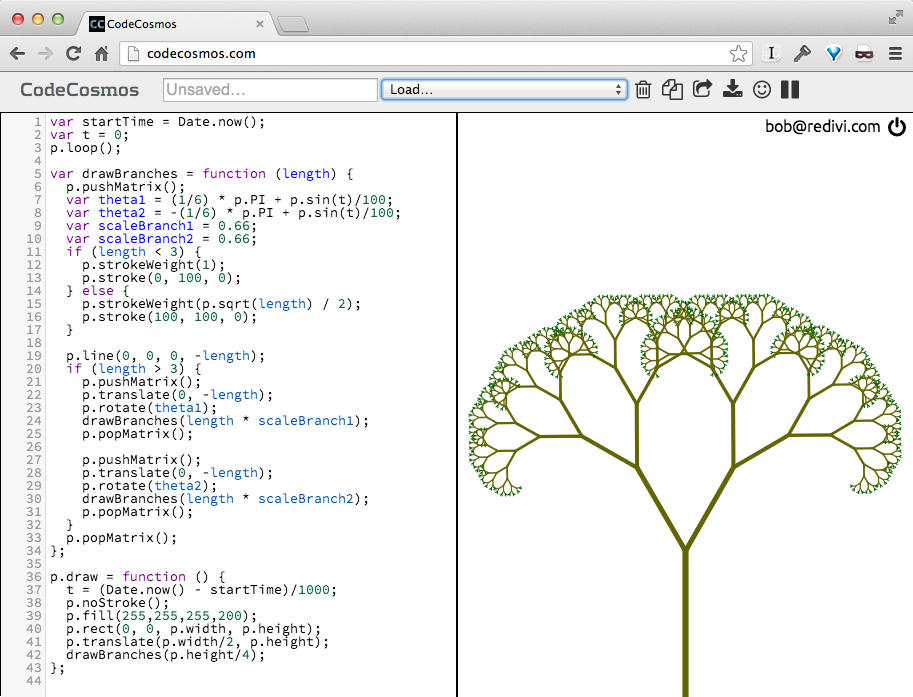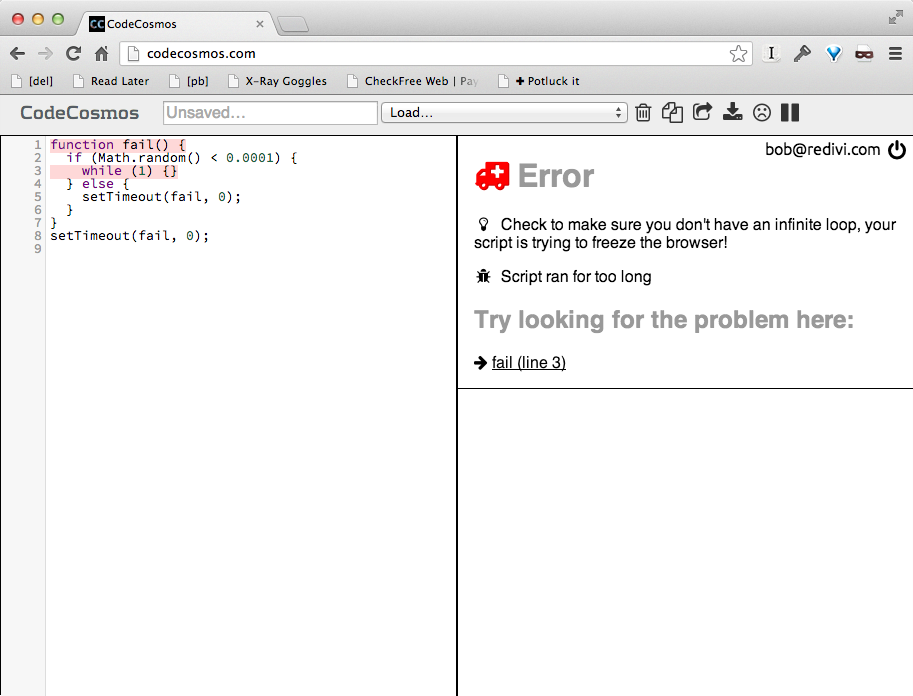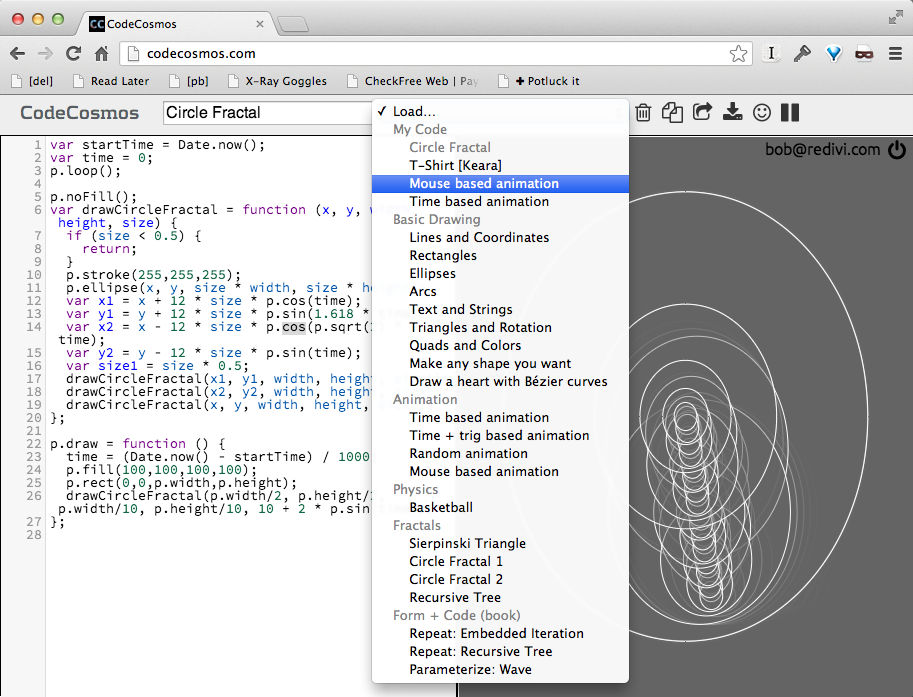How I built CodeCosmos
This is the continuation to Why I made CodeCosmos. If you’re interested in why I bothered to do this in the first place, start there. This post is just about the software itself, there’s more about how I used it to teach a class in Teaching with CodeCosmos.
TL;DR: this is the open source “stack” I used to build the first version of CodeCosmos. I’ve left out a few things that are in the code but were not actually used in the course. I may decide to elaborate further on some of these areas in future posts, but probably not until after I get around to refactoring some of the code.
- Planning
- Editing: CodeMirror, JSHint
- Sandbox: Processing.js, Esprima, Estraverse, Escodegen
- Web app: AngularJS, Font.js, jQuery, JSZipTools, Underscore
- Persistence: PouchDB, CouchDB, follow, request, node-static
- Hosting: My laptop, Github Pages, Iris Couch, nodejitsu
- Build tools: Grunt (with a few grunt-contrib tasks), Bower
- CSS and Fonts: Pure, Font Awesome, Kontrapunkt Bold, Source Code Pro, Ubuntu Regular
- Post-mortem
Planning
When I set out to teach the programming class at The College Initiative, I thought I’d be spending most of my time figuring out how to write a lesson plan and then just executing on that. I was wrong. After evaluating all of the free to use browser based learning platforms for programming that I could find, I was unable to find one that suited my needs.
I was looking for:
- A decent browser based code editor with live linting.
- I wanted to use a pragmatic programming language, not something like Scratch. My students are old enough to work, I want them to try a language that they might see in the workplace. I’d make an exception for a better teaching language for Computer Science. Maybe a Scheme dialect that transpiles cleanly to JavaScript. Especially if it could give smarter error messages given some type inference. If such a language exists, I was unable to find it.
- Processing.js support or something very much like it. I wanted the course to be visual, interactive, and more project based than lesson based. I think that “Hello World” is only exciting for students that are already genuinely interested in programming. I had a class full of students whose primary interest was getting into college. This was not a STEM program.
- Some robustness in the face of connectivity issues, which definitely rules out anything that relies heavily on streaming video.
- Persistence, both offline and online.
- The ability to detect scenarios such as infinite loops and return control to the editor. Doesn’t have to be 100% reliable, but should work well.
- As little backend as possible if I had to modify it and run it myself.
- Chrome support. I knew the lab was going to have Chrome, and I use Chrome as my primary browser. Cross-browser support can come later.
What I found:
- CodeHS - Too many hoops to jump through to get access to their free pilot. Didn’t evaluate.
- Codecademy - Decent JavaScript platform. The biggest problem here is that they basically just run the code as-is, with no watchdog-like functionality to catch infinite loops. No promise of an open source version for on-premise support.
- Khan Academy - Nice JavaScript platform, but it’s not yet possible for third parties to develop CS lessons. Their CS program isn’t open source yet (despite being live for nearly a year), so I couldn’t simply fix it to suit my needs.
- repl.it - OK JavaScript platform. I would’ve had to write a lot of code to make it possible to use something like Processing.js from a Web Worker. The sandboxing is great, but I would have to write a lot more code. I’d also have to build the code editing portion, which I was ok with.
- WeScheme - I liked the idea, but it relied on having Racket running on the server which I deemed unacceptable. Something like WeScheme but fully-hosted in the browser would be interesting. Their Bootstrap curriculum looks great.
- A handful of pastebin-like code editors (such as codepen.io, tributary.io, jsbin.com). All of them had a very straightforward execution model.
None of them had offline support. One of the open source pastebin-like code editors might have been a good base, but I decided that it would be easier to build something from lower-level components than to reverse engineer and strip down a larger application.
It turned out that making it work offline (or at least easy to host on-premise) is a must for the kind of environment I was in. Schools in low income communities in rural America have a hard enough time with reliable connectivity during the school year, and it’s so much worse in the summer. The air conditioning didn’t even work in the computer lab. This was very unpleasant on the hot and humid summer afternoons, even before the lab was full of students and busy computers.
Editing
 I’ve found that over the years that a good editor can make picking up a
language easier and more fun. By a good editor, I mean one that is augmented
to understand some of the semantics of the language you’re editing. Syntax
highlighting, bracket matching, and continuous linting were what I expected.
I also needed it to have a good API for extensibility.
From what I could find, Ace and CodeMirror are the best choices for
performant code editors in JavaScript.
I’ve found that over the years that a good editor can make picking up a
language easier and more fun. By a good editor, I mean one that is augmented
to understand some of the semantics of the language you’re editing. Syntax
highlighting, bracket matching, and continuous linting were what I expected.
I also needed it to have a good API for extensibility.
From what I could find, Ace and CodeMirror are the best choices for
performant code editors in JavaScript.
I chose CodeMirror mostly because it was easier to find a linting example that did nearly everything I wanted it to, and because WebKit adopted it for their inspector. I would’ve tested out Ace if I had noticed any major problems with CodeMirror, but I didn’t have a bad time. Ace’s website doesn’t have any example that includes more than syntax highlighting, so it would’ve been a lot more work to figure that out. I knew it was possible, because Khan Academy CS uses Ace, but CodeMirror was simply easier to start with.
The linting is performed by JSHint, with code very similar to the addon used by the linting example that ships with CodeMirror, but I made some modifications: linting runs in a Web Worker, runs a callback when done, and has a hook that lets me modify the names it recognizes as global. Linting in a Web Worker was inspired by what I saw when reverse engineering Khan Academy CS.
CodeMirror seems like it was a good choice. None of the students reported performance problems. I was able to observe a bug somewhere in CodeMirror and/or the addons that I am using. I’ll be trying to reproduce and fix it over the next few days. Basically, under some conditions, the editor gets confused about where the end of a given line is… which makes editing very painful until you find a way to rewrite that line that doesn’t confuse the editor.
Sandbox

The most novel part of CodeCosmos is the sandbox. I’m loosely using the term sandbox to refer to the execution environment for the student-written code. It’s not really sandboxed in the strictest sense of the word. The goal is just to protect the users from themselves, not other malicious users, which is just fine because I haven’t even implemented any sort of code sharing/collaboration yet.
You can’t have nice things if you crank iframe sandboxing up to 11, and you really can’t have nice things if you limit execution to a Web Worker. These aren’t necessarily fundamental limitations, but in such a restricted environment I certainly wouldn’t be able to make good use of Processing.js. I did not have the time to build something like Processing.js that would work in such a restricted environment. I may go this route in the future, the communication doesn’t currently depend on the editor and sandbox having the same origin.
I really wanted to use Processing.js because I knew other educators that had success with it, and I knew that I could rely on some Processing books to help the students and give me some ideas for lesson plans. The books I brought with me to the lab were:
- The Nature of Code
- Form+Code
- Getting Started with Processing
- The Computational Beauty of Nature - not Processing-specific, as it predates Processing, but interesting nonetheless
After reverse engineering some of Khan Academy CS I saw that they were using a Web Worker with a mock version of Processing.js to run the code once and see if anything bad happens (too many calls, or blocks for too long), and then it runs it as-is in JavaScript. There are plenty of scenarios where this isn’t going to work, especially when event handlers are involved, but it did seem to work fine for them.
I developed what I believe to be a more robust and ultimately simpler solution. I use esprima to get an AST from the student code, estraverse make some relatively cheap transformations that give me an escape hatch for bad code, and then escodegen to convert it back into JavaScript code that I can create a function out of.
The generated function adds a counter variable, and the transformation injects code to check and increment the counter every time a student-written loop is iterated or a student-written function is invoked. No transformations are done to the JavaScript libraries such as Processing.js. If the check exceeds some threshold, an exception is thrown (that Processing.js doesn’t catch) and execution of the student code is stopped. There are of course ways that this could be circumvented, but I haven’t seen a scenario where that happens when not explicitly trying to do so. The counter is currently cleared with a requestAnimationFrame timer.
The transform also adds some wrappers to catch errors and pass them to the editor, and the transform renames functions in such a way to give better name and line number information to the student when things go wrong (especially for function expressions that they did not explicitly name). I’ll probably elaborate a bit on this part of the code once I get a chance to refactor it.
Web App
The web app started off as a bunch of framework-free JavaScript code on top of CodeMirror. That quickly became unmanageable, so I added AngularJS. I also considered React and Ember, but chose AngularJS mostly because (performance aside) I’ve had good experiences with templating languages that are HTML/DOM based, and I knew I wanted something with easy to use data bindings. The templating needs of this app were minimal so I wasn’t swayed by the potential performance advantages of React. AngularJS also seems to have the most hype, and more startups that I’ve talked to recently are using it, so I wanted to take the opportunity to familiarize myself with it.
I added jQuery a bit later when I wanted to do some event handling and animation that would’ve been a bit awkward with (what I knew of) AngularJS. I may remove the jQuery dependency or replace it with Zepto later, but I chose to go with what I knew for the first version.
Font.js was added when I noticed some CodeMirror editing problems. If CodeMirror happened to load before the Source Code Pro font did, then its metrics would be off until it was refreshed. Font.js made it easy to get notified when the font was loaded so I could make this refresh happen. I originally tried Web Font Loader but I prefer how Font.js will allow me to use the font CSS as-is and still get the events. Font.js is more unobtrusive.
JSZipTools is used to facilitate the Backup button in the UI. I’m using it to dump a copy of the local database into a compressed zip file in-memory, and the createObjectURL API is used to make it downloadable without any server-side code.
Underscore was added very late and is currently used sparingly. I added it once I realized that I was implementing a handful of its features (such as debounce). I’m also a huge fan of the functional programming style, even in imperative languages, so it’s slowly being added in other places that make sense.
Overall I’m pretty happy with all these choices. I do have my plate full of refactorings that I should do now that I have a much better understanding of how AngularJS works. The AngularJS documentation could use a ton of work. It’s not the worst I’ve seen, but it’s certainly not sufficient to develop an understanding of what’s going on under the hood, and it’s far from complete. The other refactoring I’d like to do is split it all up into more discrete components that I can weave together more coherently with a loader such as RequireJS.
Persistence
 For persistence I wanted to be able to save documents locally in Web Storage
(or, ideally, IndexedDB by default with a fallback), and I wanted to be able
to push them somewhere. I wanted to ensure that it was easy to self-host and
replicate, so I chose CouchDB for the server. A future version might use
something else, but CouchDB is certainly the simplest solution for my modest
requirements.
For persistence I wanted to be able to save documents locally in Web Storage
(or, ideally, IndexedDB by default with a fallback), and I wanted to be able
to push them somewhere. I wanted to ensure that it was easy to self-host and
replicate, so I chose CouchDB for the server. A future version might use
something else, but CouchDB is certainly the simplest solution for my modest
requirements.
Given CouchDB for server-side persistence, the client-side solutions I considered were hood.ie and PouchDB. hood.ie looks interesting, but seems a bit too heavy on server-side node.js, and it’s also very alpha. I’ve had some awareness of PouchDB for a long while, and even though it’s still beta, it’s much more mature hood.ie. I did find some bugs in PouchDB, but I was able to fix or find workarounds for all of them.
PouchDB + CouchDB seemed to work just fine. I didn’t have any reports of lost work, but most of the projects started and ended on the same day. In the future I’d like to use something like Operational Transformation or Differential Synchronization near the persistence layer to facilitate conflict resolution and real-time collaboration. I’d also like to have the capability to push and pull from Git, in lieu of or in addition to CouchDB. I’ll probably be paying close attention to the progress of JS-Git.
CodeCosmos uses a database-per-user data model, both in PouchDB and CouchDB. This makes it very easy to implement the PouchDB side. I can do a simple full-table scan for a user’s data and just display it all. This is also the best way to lock things down in CouchDB, as it’s very simple to implement per-database ACLs without having to write any Document Update Handlers.
Unfortunately, CouchDB does not natively support the per-user database model.
You have to roll your own daemon to watch for new documents in _users and
create databases. I didn’t expect that I would have to deploy any services,
but I quickly put together codecosmos-node to implement this. I built
this in node.js because it was easy to do on top of the follow and request
libraries.
Sessions are stored in Web Storage’s localStorage. Not a lot of security
here yet, as I’m still using basic auth. The neat thing about localStorage
and PouchDB is that changes from one tab or browser window are immediately
propagated to other tabs via events. I’m not using any libraries here,
the APIs are rather simple and I didn’t need to do any polyfills since
the app is Chrome-only.
Hosting
CodeCosmos.com is currently hosted by GitHub Pages, with a database on Iris Couch and the daemon that creates databases is hosted on nodejitsu. I’m not happy with any of these, and I didn’t actually use any of this infrastructure in class. I don’t like GitHub Pages because I can’t enable SSL. I don’t like Iris Couch because it is unresponsive very often, although it is very nice to have a hosted CouchDB with CORS support (which is why I couldn’t try Cloudant). I don’t like nodejitsu because I just don’t have enough experience to trust it. I had scenarios where codecosmos-node stopped creating databases and required a restart. I’m not sure whether to blame node.js, nodejitsu, follow, or Iris Couch, but I’d be much happier with something in Erlang or Haskell where it is far easier to reason about failure scenarios.
For the class, everything was hosted on the LAN from my laptop with CouchDBX (what you get when you download CouchDB for Mac OS X), codecosmos-node to create databases, and a static file webserver. The first day I used mochiweb as the webserver, but I later added static file serving to codecosmos-node using node-static so that I had fewer things to keep running. I would replicate this all to the hosted CouchDB with a small script (replicate-once), because CouchDB has no built-in functionality to replicate all databases from one server to another.
I intend to migrate all of this stuff over to Rackspace Cloud, as they’re very generously providing free service for open source projects. I’ll probably just make some minor modifications to CouchDB so that I can get rid of codecosmos-node.
Build tools
It’s hardly worth mentioning because the app hardly relies on it, but I decided to use Grunt for the build/lint phases. I’m using a few grunt-contrib packages for jshint, watch, copy, and csslint. There’s a custom task to build the appcache file because I couldn’t be bothered to find the right module to do something so simple.
I used Grunt mostly because I was already using Bower and it seemed like a lot of the JavaScript dependencies of the app were using one or both of these tools. Bower is used to fetch the dependencies that are compatible with Bower. The other dependencies are simply included in the app because I’m not getting enough value with Bower to go through the hassle of wrapping them with Bower-compatible repositories.
CSS and Fonts
I’m not very good at CSS, but I have enough experience to know that less is more. I had a little experience tinkering with Pure, so I chose as a CSS framework. I’m not making great use of it, and may decide later to swap it out for something else or just hand-code what I need, but it’s working alright for now. I hope to give the app a responsive layout once I decide it’s time to support more browsers. Ideally, I would like CodeCosmos to work well on iOS and Android tablets in addition to modern desktop browsers.
I chose the Source Code Pro font for the editor, which I think looks pretty great. I knew I wanted to use a web font because the monospace fonts used by Mac and Windows are so different, and after looking at some of the coding fonts I liked this one the best.
I don’t recall where I first saw Font Awesome, but it was an easy choice for all of the iconography in the menus. The type in the menus is Ubuntu Regular. Kontrapunkt Bold is used for the “CodeCosmos” logotype in the menu.
For the login screen, I blatantly ripped off the look of Twitter’s. The source material for the background images came from HubbleSite, but I did some processing on them in Acorn first (mostly just gamma correction and brightness before resizing and compressing them for web use).


Post-mortem
Overall, I think the libraries I chose worked out pretty well. I really wish I had another week or two prior to the course to tweak the UI for usability and to build out an in-app reference for the subset of Processing.js that we used. I have a bug or two in CodeMirror to track down, and there’s a lot of work I can do to clean up the web app code and to make the persistence more robust. I’d also like to swap out the hosting choices with Rackspace Cloud.
Top priority right now is to do some more follow-up with the students, and to write the post about my experience actually teaching the course!